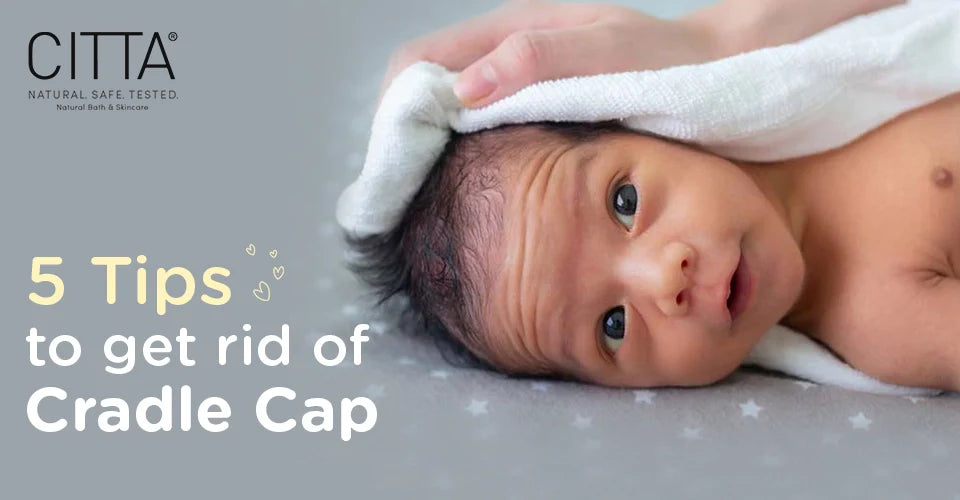5 Tips to get rid of Cradle Cap

Cradle cap is a common skin condition in babies, yet many parents can feel worried when their little one is affected by it. It is the common name for Seborrheic Dermatitis of the scalp in infants. In simpler terms, it is the baby version of dandruff. Cradle cap causes their scalp to develop yellow or white crusty patches. The patches or flakes can be oily or dry. Although it is mostly limited to the scalp, it can also affect the baby’s face, nappy area, and folds of the skin. Babies are usually affected by cradle cap in the first year of their life, most commonly around 2-4 months of age. The flaky scales look the same on all skin tones, but the skin under the scales can look different for various skin tones.
Cradle cap is not a painful condition and usually clears up on its own within a few weeks or months. It does not cause any itching or discomfort to your baby, so you need not worry too much. The cause of cradle caps in babies is not clear yet. Doctors think it might be linked to excessive sebum production by the oil glands. A type of yeast found on the skin, called Malassezia, may also have a role to play in the development of cradle caps in your baby.
Although it is not medically necessary to get rid of the cradle cap, there are a few things you can do if you want to remove it. However, you must keep in mind that these are not scientifically proven methods, so the results could be temporary. You should also remember to be gentle with your little one’s skin in all situations. Here are 5 tips to get rid of cradle cap:
Use a brush to remove the scales from your baby’s scalp
Use a gentle hair brush or toothbrush with soft bristles to loosen the flakes on your baby's hair and brush them off. Be careful to not scrape too hard at your baby’s scalp, it can be irritated easily. You can use brushes specially made for this purpose and gently brush your baby’s scalp once a day. You can do this with both wet and dry hair. If you notice any signs of redness or irritation, discontinue or reduce the number of times you brush your baby’s scalp.
Wash your baby’s hair and scalp with a gentle shampoo
Maintaining good hair hygiene can help prevent hair conditions like dry scalp, itchy scalp, and cradle cap. Washing your baby’s hair and scalp with a gentle shampoo can also help to soften the scales and temporarily remove the cradle cap scales from their scalp. Remember to use a shampoo that is free of harsh chemicals like parabens, sulfates, silicones, mineral oils, allergens, and toxins, since these chemicals can irritate your baby’s scalp. CITTA Baby Shampoo is natural, tear-free, and toxin-free – a great option for your baby. It is infused with Coconut oil, Almond oil, Olive oil, and Oats which help to hydrate and soften the cradle cap scales. They nourish your baby’s scalp and promote healthy hair growth. The gentle formulation also maintains the optimum pH balance of the scalp.
Hydrate your baby’s scalp
As mentioned previously, hydrating your baby’s scalp with natural oil can help to loosen the cradle cap scales, making it easier to remove them. Choose a natural, fragrance-free, nourishing oil such as Coconut oil or Almond oil, or a mix of 12 nourishing natural oils like CITTA’s Baby Massage Oil, and gently massage your baby’s scalp with a small quantity of oil. Be careful around the soft spot on your baby’s head. Leave the oil to absorb for around 15 minutes and then wash it out with a gentle shampoo.
Apply dermatologist-prescribed ointments or creams
If your baby’s cradle cap does not go away in a few weeks, your doctor may prescribe certain anti-fungal or zinc creams. Applying them as directed can help you get rid of the cradle cap.
Seek medical attention if the cradle cap gets infected or causes discomfort
If your baby’s cradle cap gets infected or spreads to other parts of the body, you should seek medical attention.
Cradle cap is a common condition in babies, and is usually harmless. You can try the above remedies at home for cradle cap removal, but always remember to be gentle on your baby’s skin. Only use safe, natural products that are free of harsh chemicals and gentle on your baby’s skin. Seek medical help if the rash causes discomfort.


